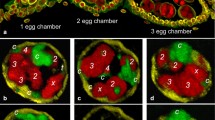Summary
A rapid method of autoradiography using the scintillation cocktail (Toluene and scintillation fluid, Omnifluor) has been described earlier. Its application and efficiency have been tested using both 3H-thymidine and 3H-uridine. The optimum time required for processing the autoradiograms has been found to be 24 h dry exposure followed by 48 h in the scintillation mixture. Detailed analysis of the autoradiograms with 3H-uridine reveals that with the rapid method the 100% level of labelling index is reached by 48 h while with the conventional method the same level is reached by 10 to 12 days of dry exposure. The maximum grain density is reached by 16 to 17 days by the conventional method. While by the rapid method, the maximum grain density is approximately 80% of the control, this grain density is reached by 48 h (plus 24 h of dry exposure) and thereafter forms a plateau. With Toluene alone the grain density never exceeds 20%. The background is also relatively low and less variable in the O-T-processed autoradiograms, as compared to the two controls. These results support that the scintillation fluid plays the key role in augmenting the labelling. Furthermore, although the maximum grain density by the rapid technique is 80% of the control, the grain density obtained by the rapid method gives less coincidence and superimposition of grains.
On the other hand, with 3H-thymidine, although all labelling patterns could be resolved, the labelling index (i.e., percent of labelled cells) is about 40% at 48 h (plus 24 h) and about 79.5% at 96 h with the rapid method, as compared to about 30% and 44% with the conventional method at the two time points, respectively. Only with 16–17 days' dry exposure the 3H-thymidine labelling index increases to 67%. The frequency of the initial patterns (DD-2C) which are usually less frequent, has been found to have increased with the rapid method. No difference in grain density of labelling of 3H-thymidine could be detected between the rapid method and the conventional method. The resolution of grains also seems to be better by the rapid method, due probably to smaller size and lack of superimposition of grains. Other applications, advantages and limitations have been discussed.
Similar content being viewed by others
References
Berendes, H.D.: Synthetic activity of polytene chromosomes. Int. Rev. Cytol. 35, 61–116 (1973)
Chatterjee, S.N., Mukherjee, A.S.: Chromosomal basis of dosage compensation in Drosophila VIII. DNA replication pattern of the puffs in the male and female larval polytene chromosomes. Cell Differ. 2, 1–19 (1973)
Chatterjee, S.N., Mukerjee, A.S.: DNA replication in polytene chromosomes of Drosophila pseudoobscura: New facts and their implications. Indian. J. exp. Biol. 13, 452–459 (1975)
Durie, B.G.M., Salmon, S.E.: High speed scinitllation autoradiography. Science 190, 1093–1095 (1975)
Feinendegen, L.E.: Tritium molecules in biology and medicine. New York: Academic Press 1969
Gaddipati, J.P., Sen, S.K.: Paradox of C-value and chromosome organization. Proc. IInd All India Congress of Cytology and Genetics, Udaipur, p. 43 (1975)
Lakhotia, S.C., Mukherjee, A.S.: Chromosomal basis of dosage compensation in Drosophila. III. Early completion of replication by the polytene X-chromosome in male: Further evidence and its implications. J. Cell Biol. 47, 18–33 (1970)
Mukherjee, A.S., Chatterjee, S.N.: Chromosomal basis of dosage compensation in Drosophila. VIII. Faster replication and hyperactivity of both arms of the X-chromosomes in males of Drosophila pseudoobscura and their possible significance. Chromosoma (Berl.) 53, 91–105 (1975)
Mukherjee, A.S., Chatterjee, S.N.: Hyperactivity and faster replicating property of the two arms of male X of Drosophila pseudoobscura. J. Microscopy 106, 199–208 (1976)
Mukherjee, A.S., Chatterjee, S.N., Chatterjee, R.N., Mondal, S.N., Nag, A., Mojumdar, D.: A rapid autoradiographic technique for chromosomal squash preparations. Indian J. exp. Biol. 13, 261–263 (1975)
Mukherjee, A.S., Chatterjee, R.N., Mondal, S.N.: A rapid method of autoradiography for squash preparations of chromosomes using scintillation fluid. Proc. IInd All India Congress of Cytology and Genetics. Udaipur, p. 77 (1975)
Pelling, C.: Ribonukleinsäure — Synthese der Riesenchromosomen. Autoradiographische Untersuchungen an Chironomus tentans. Chromosoma (Berl.) 15, 71–122 (1964)
Plant, W., Nash, D., Fanning, T.: Ordered replication of DNA in polytene chromosomes of Drosophila melanogaster. J. molec. Biol. 16, 85–93 (1966)
Przybylski, R.J.: Scintillation autoradiography: a new technique designed to augment silver grain number in radioautographs. J. Cell Biol. 43, 108a (1969)
Rodman, T.C.: Relationship of developmental steps to initiation of replication in polytene nuclei. Chromosoma (Berl.) 23, 271–278 (1968)
Author information
Authors and Affiliations
Rights and permissions
About this article
Cite this article
Mukherjee, A.S., Chatterjee, R.N. Application and efficiency of scintillation autoradiography for Drosophila polytene chromosomes. Histochemistry 52, 73–84 (1977). https://doi.org/10.1007/BF00495816
Received:
Issue Date:
DOI: https://doi.org/10.1007/BF00495816




